Agricultural Growth in Australia: An Economic Analysis
VerifiedAdded on 2023/06/12
|7
|1538
|273
AI Summary
This report analyses the recent growth of the agricultural sector in Australia with the help of a chosen newspaper report. It provides an economic analysis of the present Australian economy with the help of the supply and demand framework and provides recommendations for future growth.
Contribute Materials
Your contribution can guide someone’s learning journey. Share your
documents today.
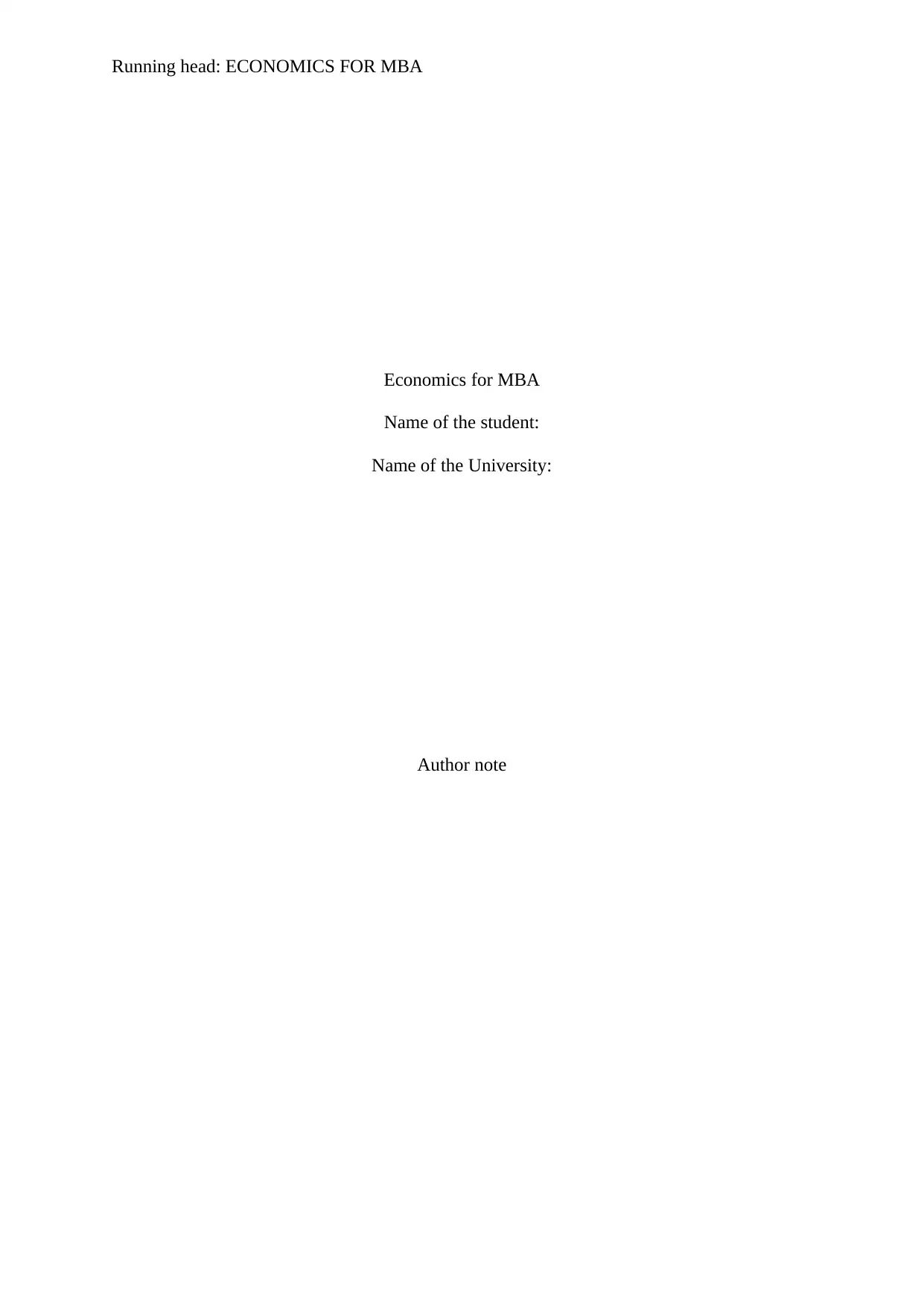
Running head: ECONOMICS FOR MBA
Economics for MBA
Name of the student:
Name of the University:
Author note
Economics for MBA
Name of the student:
Name of the University:
Author note
Secure Best Marks with AI Grader
Need help grading? Try our AI Grader for instant feedback on your assignments.
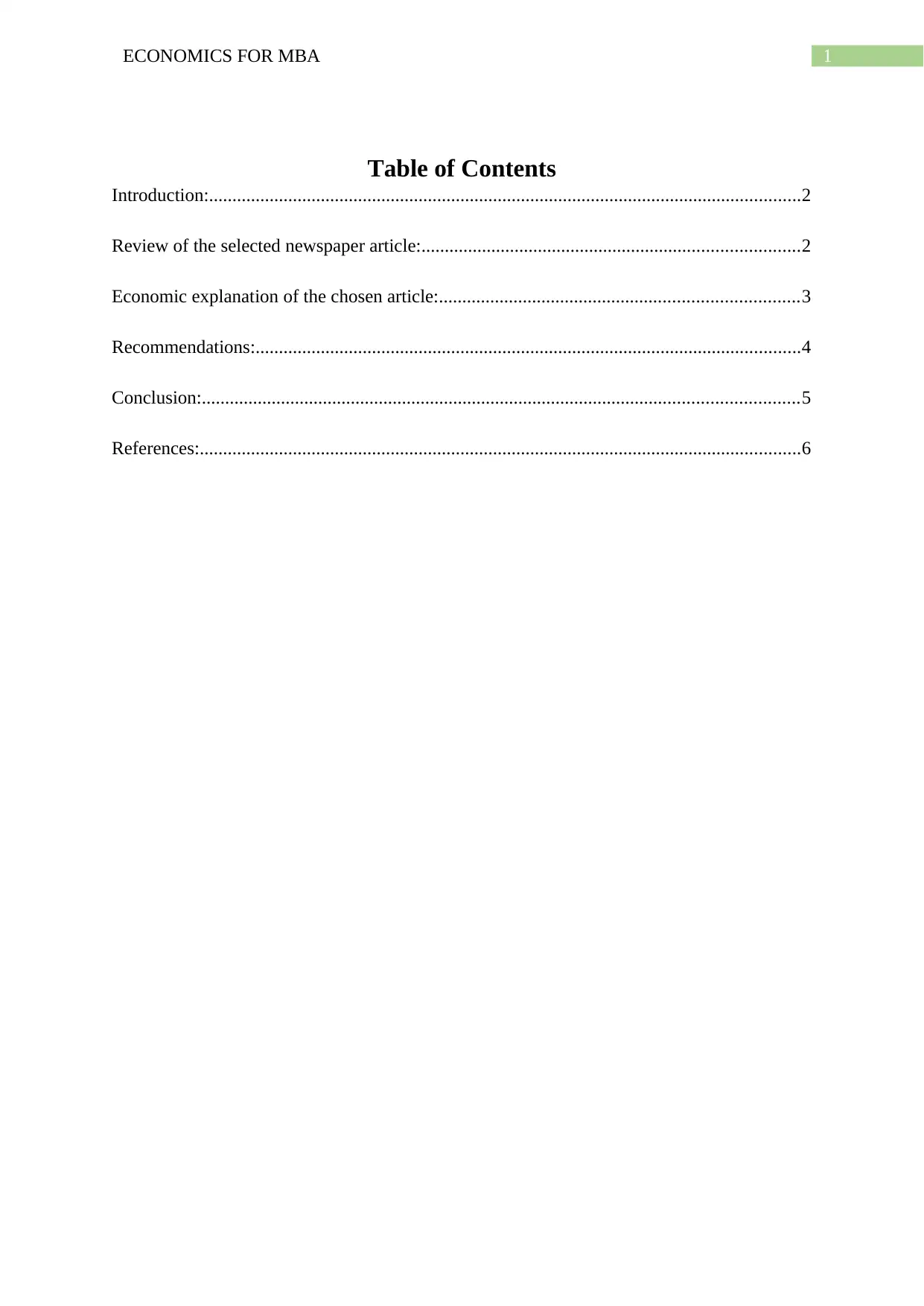
1ECONOMICS FOR MBA
Table of Contents
Introduction:...............................................................................................................................2
Review of the selected newspaper article:.................................................................................2
Economic explanation of the chosen article:.............................................................................3
Recommendations:.....................................................................................................................4
Conclusion:................................................................................................................................5
References:.................................................................................................................................6
Table of Contents
Introduction:...............................................................................................................................2
Review of the selected newspaper article:.................................................................................2
Economic explanation of the chosen article:.............................................................................3
Recommendations:.....................................................................................................................4
Conclusion:................................................................................................................................5
References:.................................................................................................................................6
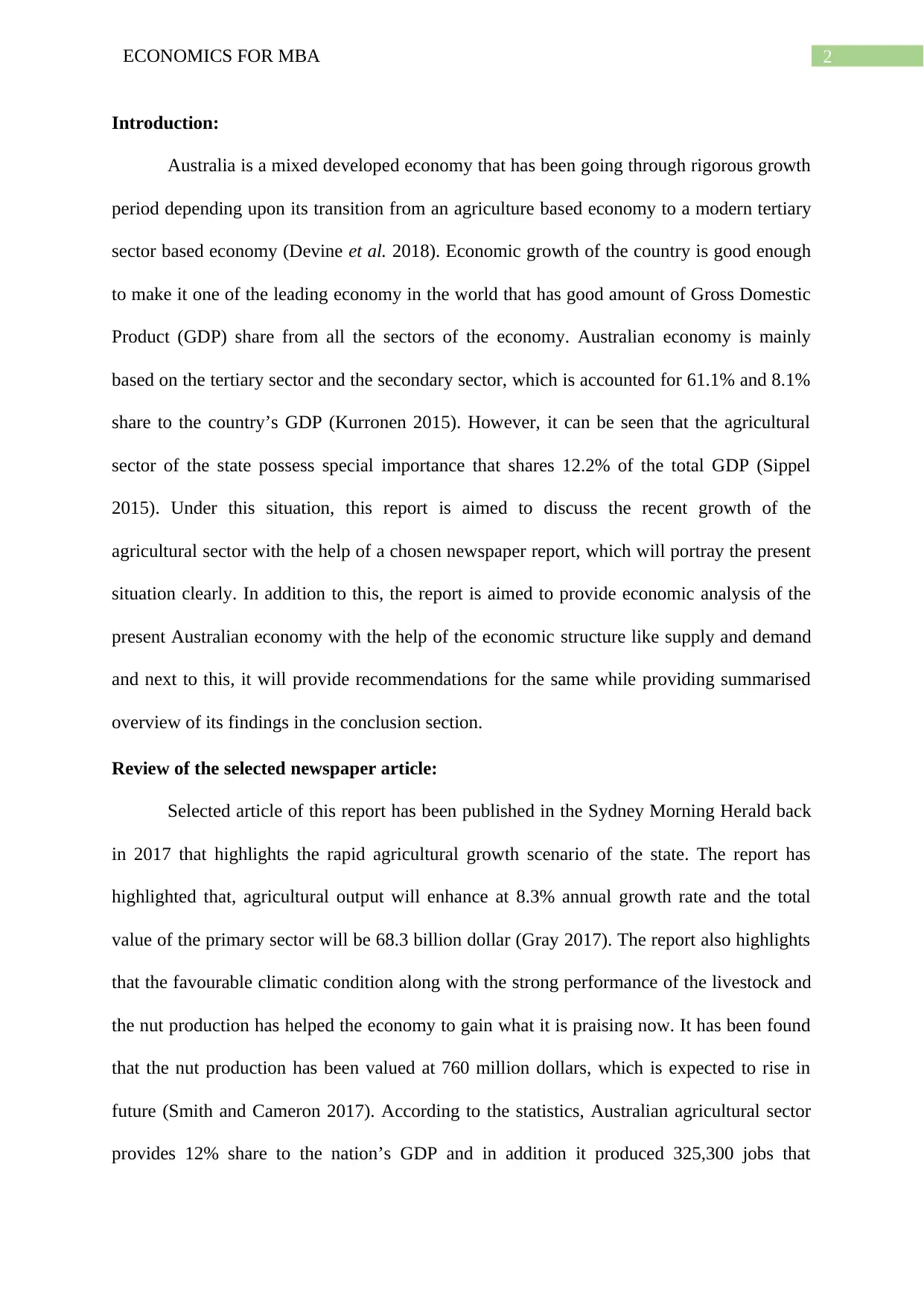
2ECONOMICS FOR MBA
Introduction:
Australia is a mixed developed economy that has been going through rigorous growth
period depending upon its transition from an agriculture based economy to a modern tertiary
sector based economy (Devine et al. 2018). Economic growth of the country is good enough
to make it one of the leading economy in the world that has good amount of Gross Domestic
Product (GDP) share from all the sectors of the economy. Australian economy is mainly
based on the tertiary sector and the secondary sector, which is accounted for 61.1% and 8.1%
share to the country’s GDP (Kurronen 2015). However, it can be seen that the agricultural
sector of the state possess special importance that shares 12.2% of the total GDP (Sippel
2015). Under this situation, this report is aimed to discuss the recent growth of the
agricultural sector with the help of a chosen newspaper report, which will portray the present
situation clearly. In addition to this, the report is aimed to provide economic analysis of the
present Australian economy with the help of the economic structure like supply and demand
and next to this, it will provide recommendations for the same while providing summarised
overview of its findings in the conclusion section.
Review of the selected newspaper article:
Selected article of this report has been published in the Sydney Morning Herald back
in 2017 that highlights the rapid agricultural growth scenario of the state. The report has
highlighted that, agricultural output will enhance at 8.3% annual growth rate and the total
value of the primary sector will be 68.3 billion dollar (Gray 2017). The report also highlights
that the favourable climatic condition along with the strong performance of the livestock and
the nut production has helped the economy to gain what it is praising now. It has been found
that the nut production has been valued at 760 million dollars, which is expected to rise in
future (Smith and Cameron 2017). According to the statistics, Australian agricultural sector
provides 12% share to the nation’s GDP and in addition it produced 325,300 jobs that
Introduction:
Australia is a mixed developed economy that has been going through rigorous growth
period depending upon its transition from an agriculture based economy to a modern tertiary
sector based economy (Devine et al. 2018). Economic growth of the country is good enough
to make it one of the leading economy in the world that has good amount of Gross Domestic
Product (GDP) share from all the sectors of the economy. Australian economy is mainly
based on the tertiary sector and the secondary sector, which is accounted for 61.1% and 8.1%
share to the country’s GDP (Kurronen 2015). However, it can be seen that the agricultural
sector of the state possess special importance that shares 12.2% of the total GDP (Sippel
2015). Under this situation, this report is aimed to discuss the recent growth of the
agricultural sector with the help of a chosen newspaper report, which will portray the present
situation clearly. In addition to this, the report is aimed to provide economic analysis of the
present Australian economy with the help of the economic structure like supply and demand
and next to this, it will provide recommendations for the same while providing summarised
overview of its findings in the conclusion section.
Review of the selected newspaper article:
Selected article of this report has been published in the Sydney Morning Herald back
in 2017 that highlights the rapid agricultural growth scenario of the state. The report has
highlighted that, agricultural output will enhance at 8.3% annual growth rate and the total
value of the primary sector will be 68.3 billion dollar (Gray 2017). The report also highlights
that the favourable climatic condition along with the strong performance of the livestock and
the nut production has helped the economy to gain what it is praising now. It has been found
that the nut production has been valued at 760 million dollars, which is expected to rise in
future (Smith and Cameron 2017). According to the statistics, Australian agricultural sector
provides 12% share to the nation’s GDP and in addition it produced 325,300 jobs that
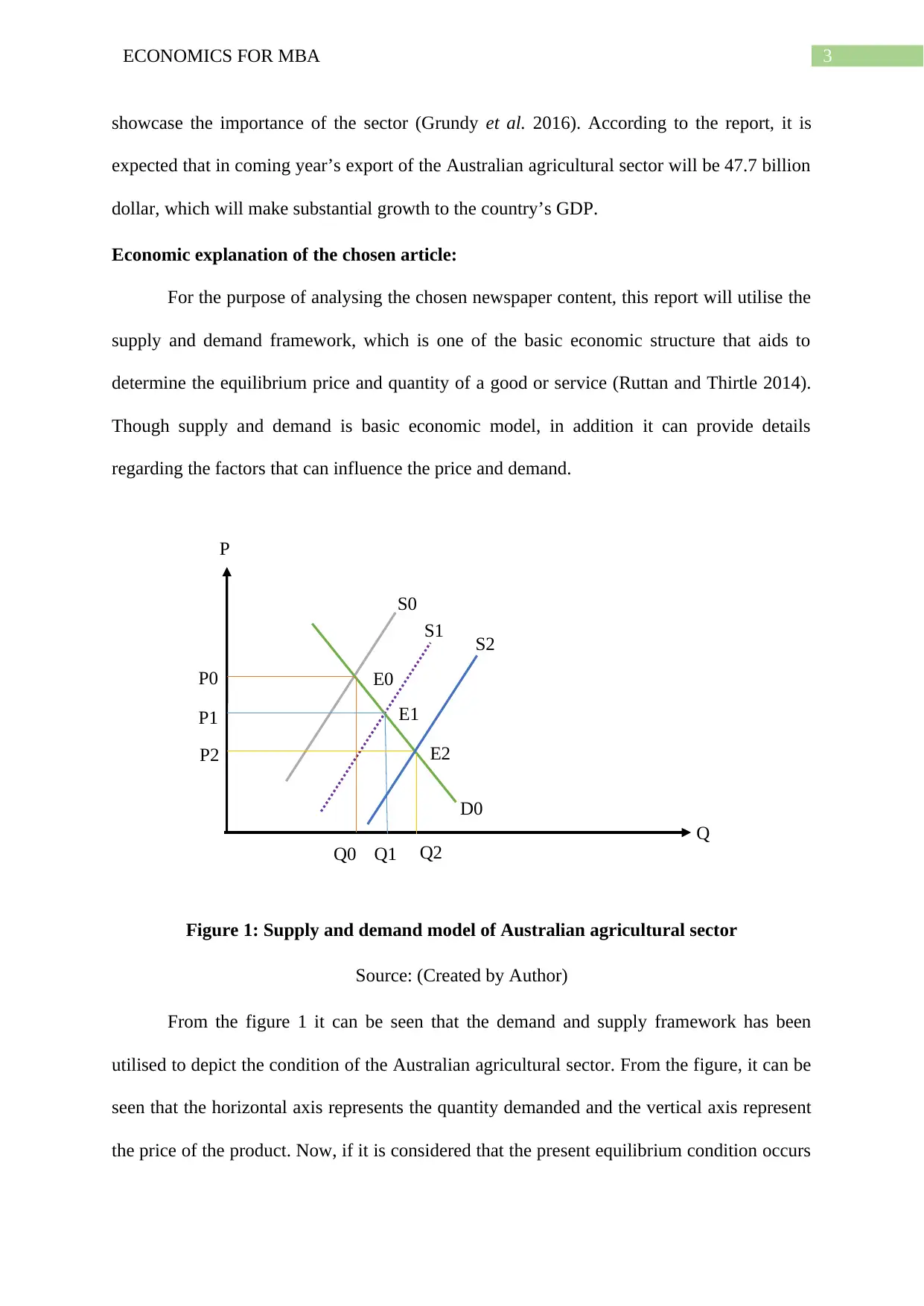
3ECONOMICS FOR MBA
Q2
D0
S0
S1 S2
E2
E1
E0
P2
P1
P0
P
Q
Q0 Q1
showcase the importance of the sector (Grundy et al. 2016). According to the report, it is
expected that in coming year’s export of the Australian agricultural sector will be 47.7 billion
dollar, which will make substantial growth to the country’s GDP.
Economic explanation of the chosen article:
For the purpose of analysing the chosen newspaper content, this report will utilise the
supply and demand framework, which is one of the basic economic structure that aids to
determine the equilibrium price and quantity of a good or service (Ruttan and Thirtle 2014).
Though supply and demand is basic economic model, in addition it can provide details
regarding the factors that can influence the price and demand.
Figure 1: Supply and demand model of Australian agricultural sector
Source: (Created by Author)
From the figure 1 it can be seen that the demand and supply framework has been
utilised to depict the condition of the Australian agricultural sector. From the figure, it can be
seen that the horizontal axis represents the quantity demanded and the vertical axis represent
the price of the product. Now, if it is considered that the present equilibrium condition occurs
Q2
D0
S0
S1 S2
E2
E1
E0
P2
P1
P0
P
Q
Q0 Q1
showcase the importance of the sector (Grundy et al. 2016). According to the report, it is
expected that in coming year’s export of the Australian agricultural sector will be 47.7 billion
dollar, which will make substantial growth to the country’s GDP.
Economic explanation of the chosen article:
For the purpose of analysing the chosen newspaper content, this report will utilise the
supply and demand framework, which is one of the basic economic structure that aids to
determine the equilibrium price and quantity of a good or service (Ruttan and Thirtle 2014).
Though supply and demand is basic economic model, in addition it can provide details
regarding the factors that can influence the price and demand.
Figure 1: Supply and demand model of Australian agricultural sector
Source: (Created by Author)
From the figure 1 it can be seen that the demand and supply framework has been
utilised to depict the condition of the Australian agricultural sector. From the figure, it can be
seen that the horizontal axis represents the quantity demanded and the vertical axis represent
the price of the product. Now, if it is considered that the present equilibrium condition occurs
Secure Best Marks with AI Grader
Need help grading? Try our AI Grader for instant feedback on your assignments.
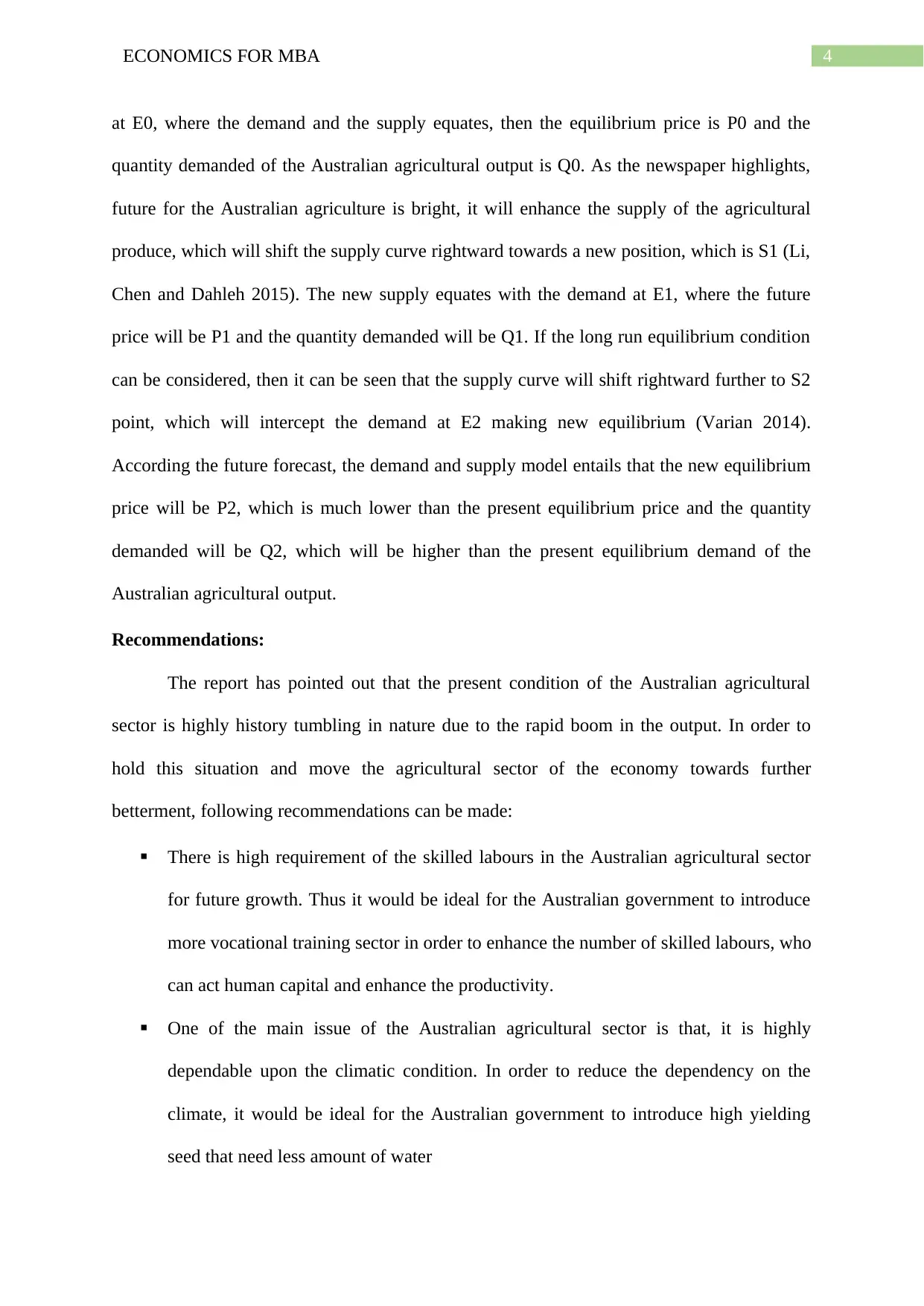
4ECONOMICS FOR MBA
at E0, where the demand and the supply equates, then the equilibrium price is P0 and the
quantity demanded of the Australian agricultural output is Q0. As the newspaper highlights,
future for the Australian agriculture is bright, it will enhance the supply of the agricultural
produce, which will shift the supply curve rightward towards a new position, which is S1 (Li,
Chen and Dahleh 2015). The new supply equates with the demand at E1, where the future
price will be P1 and the quantity demanded will be Q1. If the long run equilibrium condition
can be considered, then it can be seen that the supply curve will shift rightward further to S2
point, which will intercept the demand at E2 making new equilibrium (Varian 2014).
According the future forecast, the demand and supply model entails that the new equilibrium
price will be P2, which is much lower than the present equilibrium price and the quantity
demanded will be Q2, which will be higher than the present equilibrium demand of the
Australian agricultural output.
Recommendations:
The report has pointed out that the present condition of the Australian agricultural
sector is highly history tumbling in nature due to the rapid boom in the output. In order to
hold this situation and move the agricultural sector of the economy towards further
betterment, following recommendations can be made:
There is high requirement of the skilled labours in the Australian agricultural sector
for future growth. Thus it would be ideal for the Australian government to introduce
more vocational training sector in order to enhance the number of skilled labours, who
can act human capital and enhance the productivity.
One of the main issue of the Australian agricultural sector is that, it is highly
dependable upon the climatic condition. In order to reduce the dependency on the
climate, it would be ideal for the Australian government to introduce high yielding
seed that need less amount of water
at E0, where the demand and the supply equates, then the equilibrium price is P0 and the
quantity demanded of the Australian agricultural output is Q0. As the newspaper highlights,
future for the Australian agriculture is bright, it will enhance the supply of the agricultural
produce, which will shift the supply curve rightward towards a new position, which is S1 (Li,
Chen and Dahleh 2015). The new supply equates with the demand at E1, where the future
price will be P1 and the quantity demanded will be Q1. If the long run equilibrium condition
can be considered, then it can be seen that the supply curve will shift rightward further to S2
point, which will intercept the demand at E2 making new equilibrium (Varian 2014).
According the future forecast, the demand and supply model entails that the new equilibrium
price will be P2, which is much lower than the present equilibrium price and the quantity
demanded will be Q2, which will be higher than the present equilibrium demand of the
Australian agricultural output.
Recommendations:
The report has pointed out that the present condition of the Australian agricultural
sector is highly history tumbling in nature due to the rapid boom in the output. In order to
hold this situation and move the agricultural sector of the economy towards further
betterment, following recommendations can be made:
There is high requirement of the skilled labours in the Australian agricultural sector
for future growth. Thus it would be ideal for the Australian government to introduce
more vocational training sector in order to enhance the number of skilled labours, who
can act human capital and enhance the productivity.
One of the main issue of the Australian agricultural sector is that, it is highly
dependable upon the climatic condition. In order to reduce the dependency on the
climate, it would be ideal for the Australian government to introduce high yielding
seed that need less amount of water
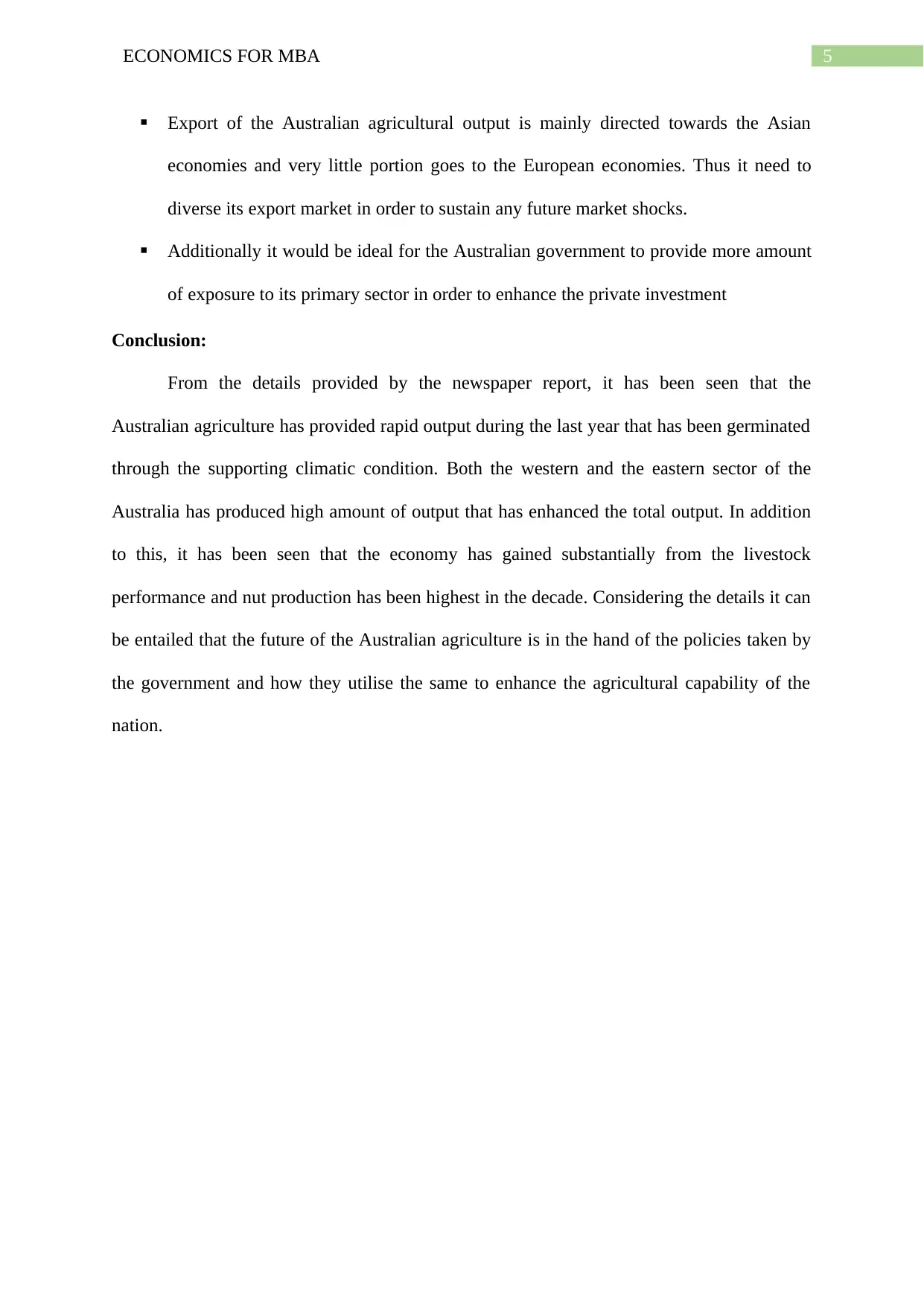
5ECONOMICS FOR MBA
Export of the Australian agricultural output is mainly directed towards the Asian
economies and very little portion goes to the European economies. Thus it need to
diverse its export market in order to sustain any future market shocks.
Additionally it would be ideal for the Australian government to provide more amount
of exposure to its primary sector in order to enhance the private investment
Conclusion:
From the details provided by the newspaper report, it has been seen that the
Australian agriculture has provided rapid output during the last year that has been germinated
through the supporting climatic condition. Both the western and the eastern sector of the
Australia has produced high amount of output that has enhanced the total output. In addition
to this, it has been seen that the economy has gained substantially from the livestock
performance and nut production has been highest in the decade. Considering the details it can
be entailed that the future of the Australian agriculture is in the hand of the policies taken by
the government and how they utilise the same to enhance the agricultural capability of the
nation.
Export of the Australian agricultural output is mainly directed towards the Asian
economies and very little portion goes to the European economies. Thus it need to
diverse its export market in order to sustain any future market shocks.
Additionally it would be ideal for the Australian government to provide more amount
of exposure to its primary sector in order to enhance the private investment
Conclusion:
From the details provided by the newspaper report, it has been seen that the
Australian agriculture has provided rapid output during the last year that has been germinated
through the supporting climatic condition. Both the western and the eastern sector of the
Australia has produced high amount of output that has enhanced the total output. In addition
to this, it has been seen that the economy has gained substantially from the livestock
performance and nut production has been highest in the decade. Considering the details it can
be entailed that the future of the Australian agriculture is in the hand of the policies taken by
the government and how they utilise the same to enhance the agricultural capability of the
nation.
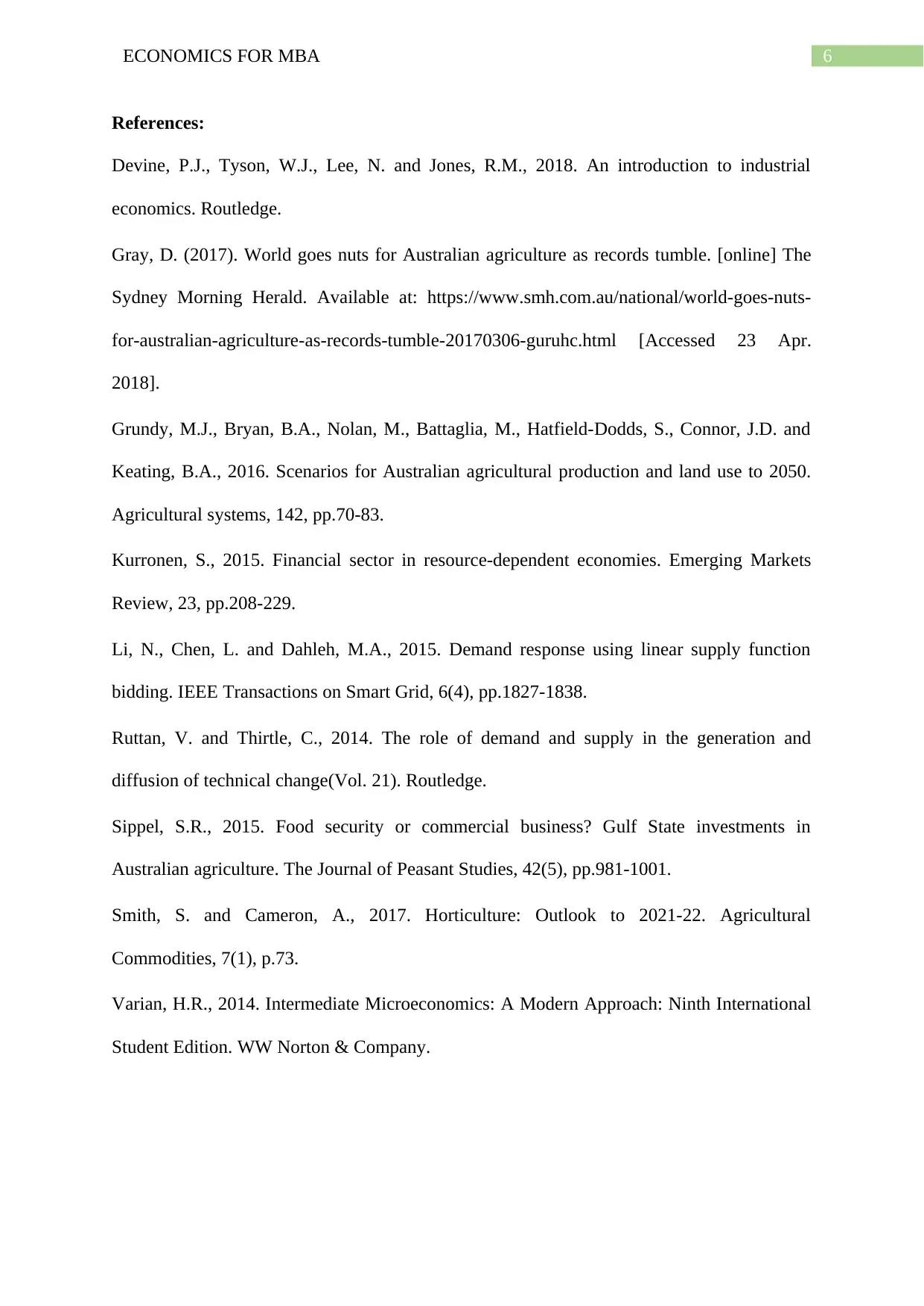
6ECONOMICS FOR MBA
References:
Devine, P.J., Tyson, W.J., Lee, N. and Jones, R.M., 2018. An introduction to industrial
economics. Routledge.
Gray, D. (2017). World goes nuts for Australian agriculture as records tumble. [online] The
Sydney Morning Herald. Available at: https://www.smh.com.au/national/world-goes-nuts-
for-australian-agriculture-as-records-tumble-20170306-guruhc.html [Accessed 23 Apr.
2018].
Grundy, M.J., Bryan, B.A., Nolan, M., Battaglia, M., Hatfield-Dodds, S., Connor, J.D. and
Keating, B.A., 2016. Scenarios for Australian agricultural production and land use to 2050.
Agricultural systems, 142, pp.70-83.
Kurronen, S., 2015. Financial sector in resource-dependent economies. Emerging Markets
Review, 23, pp.208-229.
Li, N., Chen, L. and Dahleh, M.A., 2015. Demand response using linear supply function
bidding. IEEE Transactions on Smart Grid, 6(4), pp.1827-1838.
Ruttan, V. and Thirtle, C., 2014. The role of demand and supply in the generation and
diffusion of technical change(Vol. 21). Routledge.
Sippel, S.R., 2015. Food security or commercial business? Gulf State investments in
Australian agriculture. The Journal of Peasant Studies, 42(5), pp.981-1001.
Smith, S. and Cameron, A., 2017. Horticulture: Outlook to 2021-22. Agricultural
Commodities, 7(1), p.73.
Varian, H.R., 2014. Intermediate Microeconomics: A Modern Approach: Ninth International
Student Edition. WW Norton & Company.
References:
Devine, P.J., Tyson, W.J., Lee, N. and Jones, R.M., 2018. An introduction to industrial
economics. Routledge.
Gray, D. (2017). World goes nuts for Australian agriculture as records tumble. [online] The
Sydney Morning Herald. Available at: https://www.smh.com.au/national/world-goes-nuts-
for-australian-agriculture-as-records-tumble-20170306-guruhc.html [Accessed 23 Apr.
2018].
Grundy, M.J., Bryan, B.A., Nolan, M., Battaglia, M., Hatfield-Dodds, S., Connor, J.D. and
Keating, B.A., 2016. Scenarios for Australian agricultural production and land use to 2050.
Agricultural systems, 142, pp.70-83.
Kurronen, S., 2015. Financial sector in resource-dependent economies. Emerging Markets
Review, 23, pp.208-229.
Li, N., Chen, L. and Dahleh, M.A., 2015. Demand response using linear supply function
bidding. IEEE Transactions on Smart Grid, 6(4), pp.1827-1838.
Ruttan, V. and Thirtle, C., 2014. The role of demand and supply in the generation and
diffusion of technical change(Vol. 21). Routledge.
Sippel, S.R., 2015. Food security or commercial business? Gulf State investments in
Australian agriculture. The Journal of Peasant Studies, 42(5), pp.981-1001.
Smith, S. and Cameron, A., 2017. Horticulture: Outlook to 2021-22. Agricultural
Commodities, 7(1), p.73.
Varian, H.R., 2014. Intermediate Microeconomics: A Modern Approach: Ninth International
Student Edition. WW Norton & Company.
1 out of 7
Related Documents
Your All-in-One AI-Powered Toolkit for Academic Success.
+13062052269
info@desklib.com
Available 24*7 on WhatsApp / Email
![[object Object]](/_next/static/media/star-bottom.7253800d.svg)
Unlock your academic potential
© 2024 | Zucol Services PVT LTD | All rights reserved.




